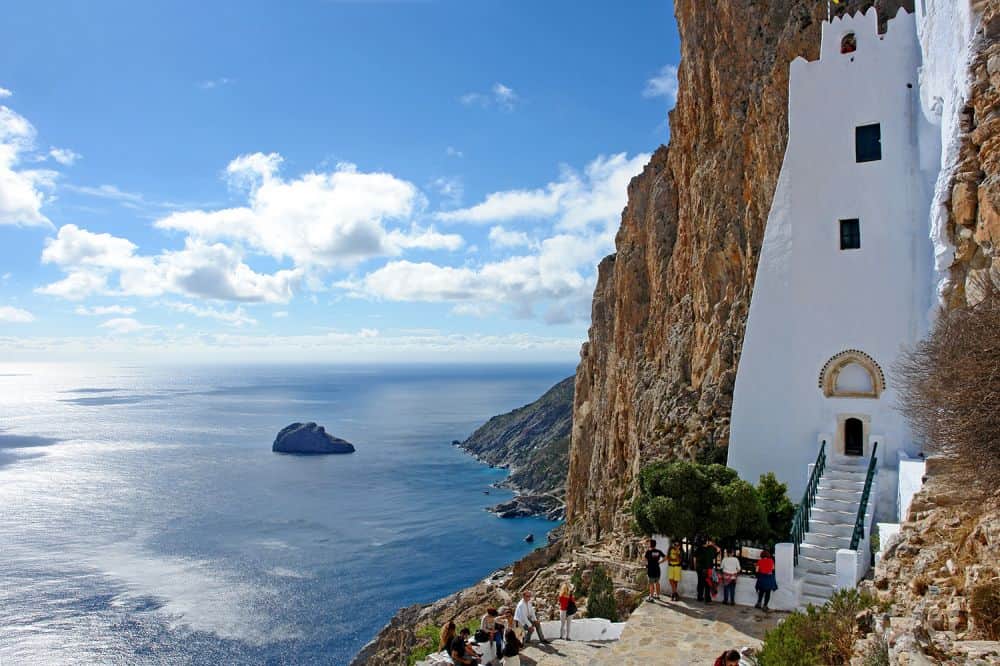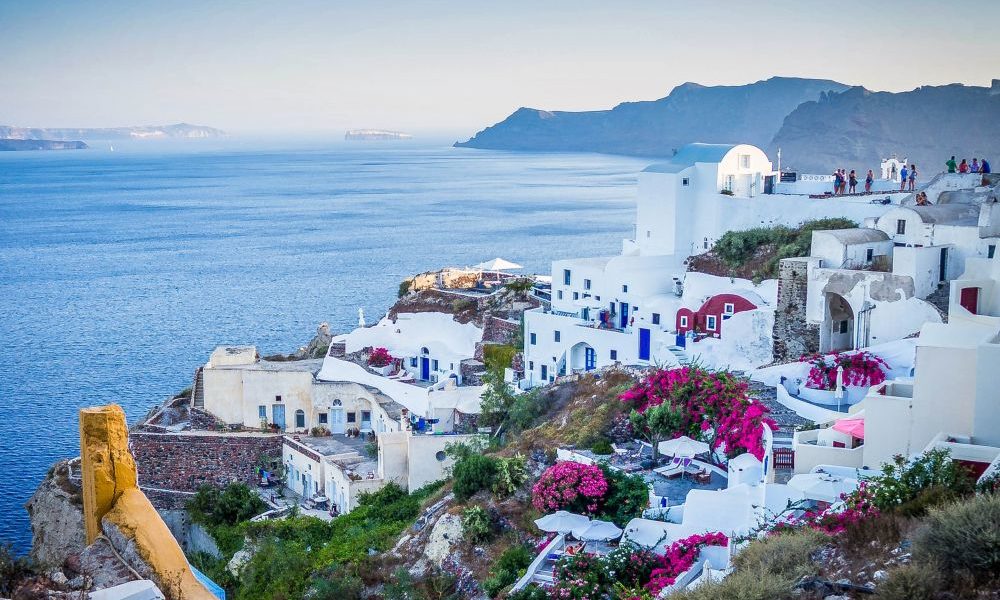
Exquisitely exclusive and strewn with floral carpets in spring and buzzily lively with both loyal and new visitors during summer, Amorgos has become highly popular since it was “discovered” in the late ‘90s, but retains its rugged and traditional allure nonetheless. It is a Cycladic gem known for its independent, charming, authentic character and dazzling natural coastal and mountainous beauty.


Village People
Amorgos has two harbours where the ferries arrive (around nine hours from Piraeus port), Aegialis and Katapola, which are around 45 minutes drive apart. Aegialis has a scenic, sandy bay and is a lovely place to swim, eat and relax, while Katapola is less of a ‘destination’ but with its own attractions. It’s essential to also explore beyond the port villages, starting with the classically Cycladic Chora. Dazzling white architecture contrasts with the sea blue doors and shutters, azure skies and the cobalt sea. Visit the Archaeological Collection of Amorgos, at the Tower of Gavras, a renovated Venetian mansion. Traipse the labyrinthine streets, admire pretty water fountains, stop to sip Greek coffee in the shade of a tree at quaint Loza cafe and visit the churches, tavernas and the castle. Other villages not to miss are Tholaria, Potamos and Lagada. The locals are known for their friendliness and filoxenia (hospitality) and will gladly direct you to the places you’d most like to discover.

Spiritual Calling
Amorgos has two of the most spectacular and oldest monasteries in the country - the Monastery of Hozoviotissa on the eastern part of the island and the monastery of Agios Georgos Valsimitis above the Chora. The former, Hozoviotissa, is the second oldest of its kind in Greece, built in 1017, and although quite a trek to clamber up to is well worth the effort. Visit the church, an ode to the Virgin Mary, and admire its miraculous icon of Panagia, which is framed by tamata. The latter, a 16th Century basilica built on the site of an ancient temple dedicated to Apollo, is where - until the practice was banned in 1967 - water divination used to take place. There, the “talking water” (called “Lalon Idor”) from the spring was “divined” to tell of the future. Today visitors love to head there not only for the deeply spiritual ambiance but also to meet the host - a friendly nun who looks after the place and its visitors as well as a huge family of cats.

Go Take a Hike
Hikers rejoice! Throughout the year, Amorgos has idyllic landscapes for scenic and invigorating hiking - regardless what degree of challenge you prefer. There are numerous well-marked routes along the ‘kalderimia’ paths that locals used for crossing the island before roads were invented, ranging from 20 minutes to several hours’ hikes, that you can easily follow using a map (and common sense). Stop to admire the dry stone walls (xerolythies) and terraces, sweeping sea views and skylines as well as bird’s eye vistas of villages and surrounding mountains and hills as you walk. Ask your hotel or check out websites like Go Amorgos for detailed and excellent ideas for your preferable trek.

Be Like the Dolphins
As the set for Luc Besson’s deep sea diving, romance and dolphin-themed film “The Big Blue” was filmed in the late ‘80s, the island famously has some stunning waters, such as those at the pebble beach of Aghia Anna, where a lot of the filming took place. Mouros, Agios Pandeleimonas, Aegialis beach, Tries Ierarches, Levrossos, Kalotaritissa, Agios Pavlos (across the islet of Nikouria) and Maltezi are some of the best beaches of Amorgos. Take your mask and flippers - or learn to dive at the local scuba school - and explore the rocky coves and caves around the coastline, or plan a sailing trip if you have the time.

Eat and Be Merry
In the excellent cookbook “The Essence of Cyclades” the authors, who spent years researching the cuisine and cultural history of this island group, write: “In Amorgos fava (yellow split peas) was a must in everyday meals, much like bread is in other regions, the honey is fragrant with the scents of thyme and sage, the goats feed on aromatic herbs and drink seawater and the cheeses have a unique local flavour.” Cheeses such as Amorgiano, Ladotyri, Axialo and Malaka are basic daily staples of the local diet, as are the above-mentioned aromatic herbs (including pungent types of thyme and oregano, vrouves (wild greens) and feskoula (chard), saffron (krokos), sea samphire (kritamo) and juicy capers. Not-to-miss traditional dishes include the crispy Amorgos cheese pies, the omelet with kavourma (pork confit) and for dessert, fouskopites (sour dough fritters), kaltsounia and the honey-drizzled xerotigana (deep fried dough strips). A local drink you’ll be (luckily) offered everywhere from a monastery to the corner taverna is Psimeni, the crystal-clear, caramel-coloured local raki drink that is cooked with honey and spices. You’ll find most of the best tavernas at Aegiali, Chora and Katapola.
Alexia Amvrazi stayed at the Aegialis Hotel & Spa in Aegialis which has a startling view of the bay of Aegialis below, regularly hosts yoga and wellness events, has an indoor and outdoor pool, serves fresh organic food produce at its restaurant and helps organize top notch tours.


